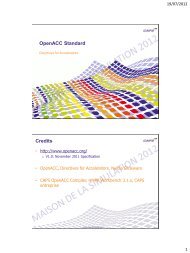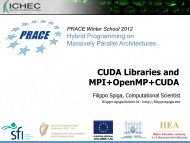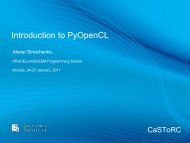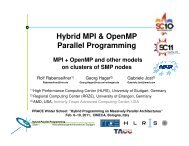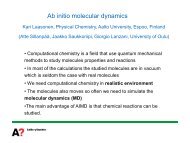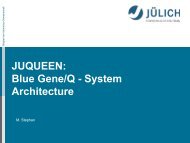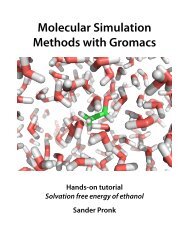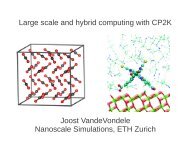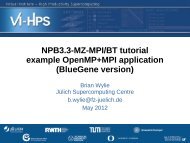Hybrid MPI and OpenMP programming tutorial - Prace Training Portal
Hybrid MPI and OpenMP programming tutorial - Prace Training Portal
Hybrid MPI and OpenMP programming tutorial - Prace Training Portal
You also want an ePaper? Increase the reach of your titles
YUMPU automatically turns print PDFs into web optimized ePapers that Google loves.
Opportunities, if <strong>MPI</strong> speedup is limited due toalgorithmic problems• Algorithmic opportunities due to larger physical domains inside ofeach <strong>MPI</strong> process If multigrid algorithm only inside of <strong>MPI</strong> processes If separate preconditioning inside of <strong>MPI</strong> nodes <strong>and</strong> between<strong>MPI</strong> nodes If <strong>MPI</strong> domain decomposition is based on physical zonesTo overcome <strong>MPI</strong> scaling problems• Reduced number of <strong>MPI</strong> messages,compared to pure <strong>MPI</strong>reduced aggregated message size• <strong>MPI</strong> has a few scaling problems– H<strong>and</strong>ling of more than 10,000 <strong>MPI</strong> processes– Irregular Collectives: <strong>MPI</strong>_....v(), e.g. <strong>MPI</strong>_Gatherv() Scaling applications should not use <strong>MPI</strong>_....v() routines– <strong>MPI</strong>-2.1 Graph topology (<strong>MPI</strong>_Graph_create) <strong>MPI</strong>-2.2 <strong>MPI</strong>_Dist_graph_create_adjacent– Creation of sub-communicators with <strong>MPI</strong>_Comm_create <strong>MPI</strong>-2.2 introduces a new scaling meaning of <strong>MPI</strong>_Comm_create– … see P. Balaji, et al.: <strong>MPI</strong> on a Million Processors. Proceedings EuroPVM/<strong>MPI</strong> 2009.• <strong>Hybrid</strong> <strong>programming</strong> reduces all these problems (due to a smaller number of processes)<strong>Hybrid</strong> Parallel ProgrammingSlide 117 / 154Rabenseifner, Hager, Jost<strong>Hybrid</strong> Parallel ProgrammingSlide 118 / 154Rabenseifner, Hager, JostSummary: Opportunities of hybrid parallelization(<strong>MPI</strong> & <strong>OpenMP</strong>)• Nested Parallelism Outer loop with <strong>MPI</strong> / inner loop with <strong>OpenMP</strong>• Load-Balancing Using <strong>OpenMP</strong> dynamic <strong>and</strong> guided worksharing• Memory consumption Significantly reduction of replicated data on <strong>MPI</strong> level• Opportunities, if <strong>MPI</strong> speedup is limited due to algorithmic problem Significantly reduced number of <strong>MPI</strong> processes• Reduced <strong>MPI</strong> scaling problems Significantly reduced number of <strong>MPI</strong> processesOutline• Introduction / Motivation• Programming models on clusters of SMP nodes• Case Studies / pure <strong>MPI</strong> vs hybrid <strong>MPI</strong>+<strong>OpenMP</strong>• Practical “How-To” on hybrid <strong>programming</strong>• Mismatch Problems• Opportunities:Application categories that can benefit from hybrid parallelization• Thread-safety quality of <strong>MPI</strong> libraries• Tools for debugging <strong>and</strong> profiling <strong>MPI</strong>+<strong>OpenMP</strong>• Other options on clusters of SMP nodes• Summary<strong>Hybrid</strong> Parallel ProgrammingSlide 119 / 154Rabenseifner, Hager, Jost<strong>Hybrid</strong> Parallel ProgrammingSlide 120 / 154Rabenseifner, Hager, Jost




